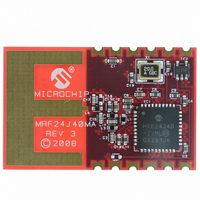MRF24J40MA-I/RM Microchip Technology, MRF24J40MA-I/RM Datasheet - Page 17

MRF24J40MA-I/RM
Manufacturer Part Number
MRF24J40MA-I/RM
Description
MODULE RF TXRX PICTAIL PLUS
Manufacturer
Microchip Technology
Datasheet
1.MRF24J40MA-IRM.pdf
(30 pages)
Specifications of MRF24J40MA-I/RM
Frequency
2.4GHz
Data Rate - Maximum
250kbps
Modulation Or Protocol
802.15.4
Applications
ISM, ZigBee™
Power - Output
0dBm
Sensitivity
-94dBm
Voltage - Supply
2.4 V ~ 3.6 V
Current - Receiving
19mA
Current - Transmitting
23mA
Data Interface
PCB, Surface Mount
Antenna Connector
On-Board, Trace
Operating Temperature
-40°C ~ 85°C
Package / Case
Module
Wireless Frequency
2.4 GHz
Interface Type
4-Wire SPI
Output Power
+ 3 dBm
Operating Supply Voltage
3.3 V
Maximum Operating Temperature
+ 85 C
Mounting Style
SMD/SMT
Minimum Operating Temperature
- 40 C
Modulation
OQPSK
Frequency Range
2.405GHz To 2.48GHz
Data Rate Max
250Kbps
Module Interface
SPI, 4-Wire
Supply Voltage Range
2.4V To 3.6V
Supply Current
23mA
Operating Temperature Range
-40°C To +85°C
Rohs Compliant
Yes
Sensitivity (dbm)
-94dBm
Lead Free Status / RoHS Status
Lead free / RoHS Compliant
Memory Size
-
Lead Free Status / Rohs Status
Lead free / RoHS Compliant
Other names
MRF24J40MA
MRF24J40MA
MRF24J40MA
Available stocks
Company
Part Number
Manufacturer
Quantity
Price
Company:
Part Number:
MRF24J40MA-I/RM
Manufacturer:
MICROCHIP
Quantity:
12 000
3.0
The MRF24J40MA module has received regulatory
approvals for modular devices in the United States,
Canada and European countries. Modular approval
allows the end user to place the MRF24J40MA module
inside a finished product and not require regulatory
testing for an intentional radiator (RF transmitter), pro-
vided no changes or modifications are made to the
module circuitry. Changes or modifications could void
the user’s authority to operate the equipment. The end
user must comply with all of the instructions provided
by the Grantee, which indicate installation and/or
operating conditions necessary for compliance.
The integrator may still be responsible for testing the end
product for any additional compliance requirements
required with this module installed (for example: digital
device emission, PC peripheral requirements, etc.) in
the specific country that the end device will be marketed.
Annex F of the IEEE Std. 802.15.4 document has a good
summary of regulatory requirements in various countries
concerning IEEE Std. 802.15.4 devices. The standard
can be downloaded from the IEEE Standards web page:
http://standards.ieee.org/getieee802/802.15.html.
Refer to the specific country radio regulations for
details on regulatory compliance.
3.1
The MRF24J40MA has received Federal Communica-
tions Commission (FCC) CFR47 Telecommunications,
Part 15 Subpart C “Intentional Radiators” 15.247 and
modular approval in accordance with FCC Public
Notice DA 00-1407 Released: June 26, 2000, Part 15
Unlicensed
MRF24J40MA module can be integrated into a finished
product without obtaining subsequent and separate
FCC approvals.
The MRF24J40MA module has been labeled with its
own FCC ID number, and if the FCC ID is not visible
when the module is installed inside another device,
then the outside of the finished product into which the
module is installed must also display a label referring to
the enclosed module. This exterior label can use
wording such as the following:
© 2008 Microchip Technology Inc.
Contains Transmitter Module FCC ID:
OA3MRF24J40MA
-or-
Contains FCC ID: OA3MRF24J40MA
This device complies with Part 15 of the FCC Rules.
Operation is subject to the following two conditions:
(1) this device may not cause harmful interference,
and (2) this device must accept any interference
received, including interference that may cause
undesired operation.
REGULATORY APPROVAL
United States
Modular
Transmitter
Approval.
The
The user’s manual should include the following
statement:
3.1.1
All transmitters regulated by FCC must comply with RF
exposure requirements. OET Bulletin 65 “Evaluating
Compliance with FCC Guidelines for Human Exposure
to Radio Frequency Electromagnetic Fields” provides
assistance in determining whether proposed or existing
transmitting facilities, operations or devices comply
with limits for human exposure to Radio Frequency
(RF) fields adopted by the Federal Communications
Commission (FCC). The bulletin offers guidelines and
suggestions for evaluating compliance.
If appropriate, compliance with exposure guidelines for
mobile and unlicensed devices can be accomplished
by the use of warning labels and by providing users
with information concerning minimum separation
distances from transmitting structures and proper
installation of antennas.
This equipment has been tested and found to comply
with the limits for a Class B digital device, pursuant to
part 15 of the FCC Rules. These limits are designed to
provide
interference
equipment generates, uses and can radiate radio
frequency energy, and if not installed and used in
accordance with the instructions, may cause harmful
interference to radio communications. However, there
is no guarantee that interference will not occur in a
particular installation. If this equipment does cause
harmful interference to radio or television reception,
which can be determined by turning the equipment off
and on, the user is encouraged to try to correct the
interference by one or more of the following measures:
• Reorient or relocate the receiving antenna.
• Increase the separation between the equipment
• Connect the equipment into an outlet on a
• Consult the dealer or an experienced radio/TV
and receiver.
circuit different from that to which the receiver is
connected.
technician for help.
reasonable
RF EXPOSURE
in
MRF24J40MA
a
residential
protection
installation.
against
DS70329B-page 15
harmful
This














